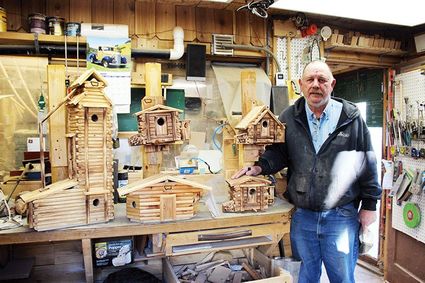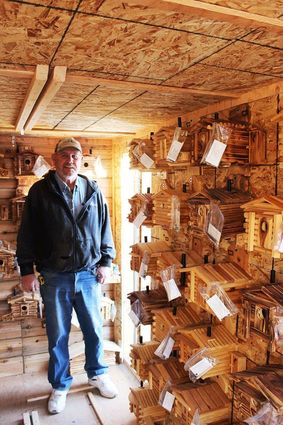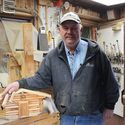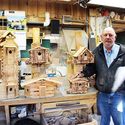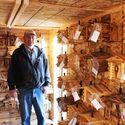Roy Case has a passion for building unique birdhouses
December 6, 2017
Reporter's note: I believe the first time I saw Roy Case, and the line of "unique Montana-style birdhouses" he builds and sells, was at the Seed Show in Harlem last year. Since then I've seen him at other bazaars and community events. He's created a style of birdhouse that is beyond the more traditional with just four walls and a roof. His birdhouses are eye-catching and require some close examination to really see and appreciate their detail and distinctive style.
On Roy's business card, after his name, reads "Wood Butcher." Even that got my attention and raised my curiosity. I recently visited his workshop south of Chinook on Cleveland Road. Here's some of what I learned about how he got passionate about building Western Cedar Birdhouses.
Scrap wood inspired a new product
Roy Case said he never really considered himself a woodworker. He explained, "I did a few projects around the house building shelves and counters and even a coffee table. Scott DePriest had some ends of boards he'd used to build a cedar fence around his house. They were short pieces and I got them to line a cargo trailer I was fixing up." Once the trailer was lined he still had some pieces left and began toying with what he could do with them.
"My first inclination," he recalled, "was to make some picture frames." After he cut one of the boards in to one inch square strips, he made a round edge on a strip using his router. "I looked at the rounded strip and wondered what it would look like if I rounded the other edge. With two rounded edges the strip looked like a log." He's not sure how the final birdhouse idea popped into his head, but the wood looking like miniature logs got the creative juices flowing.
The first style, which he still makes a variation of, was a 'duplex birdhouse' with a false front door and openings on each side of the house for the birds. After selling a few of those a customer asked, "Can you do any other style of birdhouse?" He experimented some more and began making single houses, the style that still drives most of the birdhouses he currently makes.
He said, "I got the first single houses completed. Looking at them I thought, 'Something is missing.'" That's when began adding the little outhouse, woodpile and smoke stack that tends to identify his birdhouses. "Now," Case added, "every house has something unique about it." Sure enough, studying the 20 or so houses he had hanging in the drying room of his shop, I could see slight variations on the theme in every one of them." One thing the same on every house is a burned brand in the outline of Montana.
The building process
Case said, "When I sold my first few birdhouses I realized I needed to have a shop, so I built one next to the house." Right away that proved too small so he built an addition. The addition has a compact wood stove and is used, primarily, for drying the birdhouses once they are completed.
He buys wood by the unit-a unit has 400 boards in it and it takes two and a quarter boards to make each house. Case has already used nearly three units of lumber. All 52 pieces in a typical house come from boards cut into square strips. He added, "The only pieces on the house I don't cut and shape myself are the dowels I buy to make the smoke stack and perch." He typically cuts enough of each piece to build 20 birdhouses.
Then he glues and nails each unit and adds the various parts to make his distinctive looking houses. At first all the houses were clear. He 'burns' most of them now, using a small propane torch to lightly blacken the completed house. He explained, "I've learned that the burned houses sell about 10:1 over the clear ones.
The last stage of assembly is where Case adds the touches that makes each one different. He said, "Making each one different is how I reward myself and express my creativity." He showed one house with a bell tower, complete with bell. Another had a doghouse instead of an outhouse. There was even a "special edition" that commemorates the August eclipse. . Some of the houses are 'wall' mounted and some are 'base' mounted. He even has a display model with a swing away back to give customers a "birds-eye-view" of the inside of the house.
He builds five houses at a time. The final step is to paint them with spar urethane and let them dry on the walls and racks in his drying room. Time to assemble each unit, per Case, is roughly two hours total.
Recently his wife suggested building wall clocks. Case had one on display in his shop, noting it was the only one he'd made so far. The clock has the look of a birdhouse with clock hands where the front hole for the bird would be. He said, "Because the clock is shallow the parts are very small and hard to work with. I think I'll make 10 clocks, number them as a limited edition and that will be it." Those ten could be collector's items...
First sale took three minutes online
Case posted his first birdhouse for sale on the Chinook Yard Sale site in March, 2015. The first house sold in three minutes and, he added, "By the end of the day I'd sold 25." He figures to date he's sold about 325 and they've gone to four Canadian provinces and 14 U.S. states from Alaska to North Carolina.
He does about 7-8 community events a year and is learning which ones work best for selling the birdhouses. A florist in Malta has already bought 30, which she resells in her shop. He's hoping to be invited to the Montana state meeting of florists to showcase the birdhouses.
Outside the back door of his shop is a cargo trailer that Case has customized for hauling his houses to shows and sales events. He explained, "I have 167 birdhouses in the trailer when it's full. I can hang another 30 on the wall in my drying room. My current goal is to start into the holiday season with about 200 houses on hand. I can make more when I need them but still have plenty to sell as needed."
The standard birdhouse sells for $30. He has an "elevator style" that can accommodate multiple birds and it's more expensive. Case asked me when I talked to him at a show, what I thought the birdhouses should cost. Looking at them, I guessed a figure quite a bit higher than his current selling price. He said "Everyone thinks I should be charging more. I never got into the project for money. I figure I'm making about $7 an hour for my time." He added, "My reward is to see the look on peoples' faces when they get a birdhouse. That's priceless."
The future for Western Cedar Birdhouses
Case said, "I've thought about ways to sell the birdhouses on a broader scale." One idea is to create an interactive website and ship houses. The houses meet the dimensions required for the Post Office to deliver to a mailbox. He's also considering expanding the number of community events and bazaars he might attend. Should sales take a jump, he added, "I have a friend who is ready to help me cut pieces for the houses, then bring them to my shop for assembly."
However Western Cedar Birdhouses develops, it seems fairly clear Case will keep his enthusiasm for the work. There's a twinkle in his eye every time he describes one of the birdhouses, it's obviously a labor of love. You can get more information about the birdhouses by calling Roy Case at 406-357-4123.

